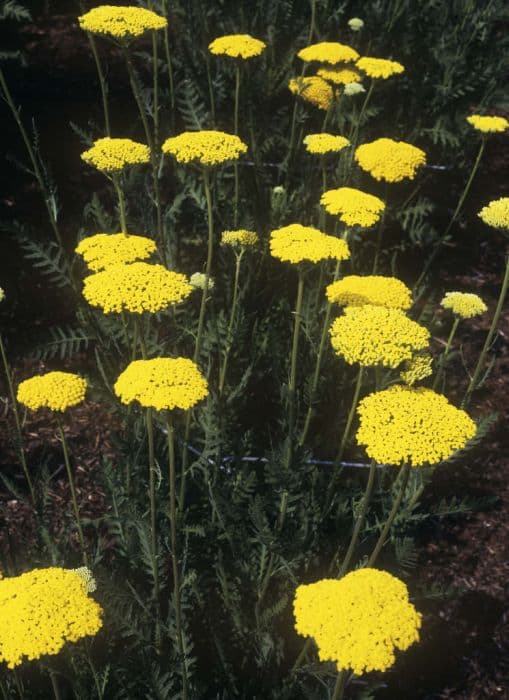Stoke's Aster Stokesia laevis 'Omega Skyrocket'

ABOUT
The 'Omega Skyrocket' is a variety of the plant commonly known as Stoke's aster. It is characterized by its striking flowers and lush foliage. The flowers are particularly noteworthy, boasting a unique color palette that transitions from a deep blue at the base to a lighter, almost sky-blue hue towards the edges of each petal. Each bloom is composed of multiple slender petals radiating outwards from a central point, creating an overall appearance reminiscent of a starburst or firework. These flowers form a dense cluster that sits atop the foliage, adding a pop of color that draws the eye. The foliage itself consists of elongated, lance-shaped leaves that are rich green in color. These leaves are arranged in a rosette pattern at the base of the plant, creating a foundation of verdant green that contrasts with the vivid blossoms above. The texture of both the leaves and the petals is smooth, adding to the plant's lush appearance. 'Omega Skyrocket' is often praised for the effect it brings to gardens, providing a vertical element of color and texture that complements other plants well. It is commonly used in borders, beds, and as a specimen plant, where its ornamental qualities can be fully appreciated. It adds a sense of depth and complexity to garden compositions without overwhelming other plantings.
About this plant
 Names
NamesFamily
Asteraceae
Synonyms
Omega Skyrocket Stokes' Aster, Omega Skyrocket Stokesia
Common names
Carthamus laevis, Stokesia laevis, Centaurea stokesia.
 Toxicity
ToxicityTo humans
Stokes' Aster is generally not known for being toxic to humans. It is not listed as a poisonous plant, and there are no well-documented adverse reactions or symptoms associated with ingesting parts of this plant. However, it is always advisable to exercise caution and avoid eating ornamental plants as they are not intended for human consumption.
To pets
Stokes' Aster is also not known to be toxic to pets. There are no significant reports of toxicity in animals such as dogs and cats. As with humans, it's still a good practice to prevent pets from ingesting plants not intended for their consumption to avoid any potential stomach upset or unforeseen allergic reactions.
 Characteristics
CharacteristicsLife cycle
Perennials
Foliage type
Evergreen
Color of leaves
Green
Flower color
Lavender
Height
2 feet (0.61 meters)
Spread
2 feet (0.61 meters)
Plant type
Herb
Hardiness zones
5
Native area
North America
Benefits
 General Benefits
General Benefits- Attractive Blooms: Stokesia laevis 'Omega Skyrocket', or Stokes aster, produces striking, blue-violet flowers that add color and interest to gardens.
- Nectar Source: The flowers attract butterflies and other pollinators, enhancing biodiversity in the garden.
- Easy to Grow: Stokes aster is known for being low maintenance and easy to care for, making it suitable for gardeners of all levels.
- Drought Tolerance: Once established, it has good drought tolerance, reducing the need for frequent watering.
- Long Blooming Season: It has a lengthy flowering period from mid-summer to fall, providing long-lasting garden interest.
- Cold Hardy: The plant is cold hardy, allowing it to survive and thrive in cooler climates.
- Deer Resistance: Stokes aster is generally resistant to deer, which can be advantageous in areas where deer browsing is a problem.
 Medical Properties
Medical PropertiesThis plant is not used for medical purposes.
 Air-purifying Qualities
Air-purifying QualitiesThis plant is not specifically known for air purifying qualities.
 Other Uses
Other Uses- As a natural dye: The petals of the Stokes' aster can be used to create natural dyes for textiles, providing various shades of purples and blues depending on the mordant used.
- Photography prop: The visually striking blooms can add a pop of color and interest in macro photography or as part of a styled botanical photoshoot.
- Artistic inspiration: Artists may use the Stokes' aster as a subject matter for paintings, drawings, and other forms of botanical art due to its vivid colors and unique flower structure.
- Craft projects: Dried stems and flowers can be incorporated into homemade paper, providing texture and visual appeal to the final product.
- Educational tool: In a classroom setting, the plant can be used to teach students about pollination, plant biology, and horticultural practices.
- Garden design: Can serve as an inspiration for color schemes or themes in garden design, particularly cottage garden themes.
- Eco-friendly confetti: Dried petals of the Stokes' aster can be used as a biodegradable confetti alternative for celebrations.
- Floral arrangements: Not only for their beauty but also for their structural interest in both fresh and dried floral arrangements.
- Insect habitat: Although this is a natural use, incorporating the plant in gardens can provide habitat and food sources for beneficial insects like bees and butterflies.
- Soil erosion control: Stokes' aster can be used in landscaping to help stabilize soil and prevent erosion due to its clumping growth habit.
Interesting Facts
 Feng Shui
Feng ShuiThe Stokes' Aster is not used in Feng Shui practice.
 Zodiac Sign Compitability
Zodiac Sign CompitabilityThe Stokes' Aster is not used in astrology practice.
 Plant Symbolism
Plant Symbolism- Uniqueness: The Stokesia laevis 'Omega Skyrocket', commonly known as the Stokes' Aster, boasts a distinctive flower shape, which can symbolize one's unique personality or distinctive qualities.
- Endurance: Stokes' Aster is known for its hardiness and ability to thrive in various conditions, representing resilience and the ability to persevere through challenges.
- Charm: With its attractive blooms, Stokes' Aster often symbolizes enchantment and a captivating presence.
- Remembrance: Flowers, in general, can signify memories, and the Stokes' Aster is no different, often used to denote fond memories or to serve as a reminder of past experiences.
 Water
WaterStokes' aster prefers consistent moisture, so aim to water it thoroughly when the top inch of soil feels dry to the touch. This typically means watering once a week, but you may need to adjust depending on weather conditions and soil drainage. A good soak with about one gallon of water per plant should suffice, ensuring the plant’s root zone is well hydrated. During the hotter, drier months, you might need to water more frequently. Always avoid overhead watering to keep the foliage dry and prevent fungal diseases. Make sure the plant is in well-draining soil to prevent root rot from overwatering.
 Light
LightThe Stokes' aster thrives best in full sunlight to partial shade. For optimal growth and flowering, plant it in a location where it can receive at least 6 to 8 hours of direct sunlight daily. A spot that offers morning sunlight and afternoon shade would be ideal, especially in areas with hot summers. Too much shade can lead to leggy plants and reduced flowering.
 Temperature
TemperatureStokes' aster grows well in a wide range of temperatures, but it prefers a climate where the temperatures are between 60 and 80 degrees Fahrenheit. It can tolerate minimum temperatures down to about 20 degrees Fahrenheit but may suffer if exposed to extreme cold below this range. Maximum temperatures for the plant shouldn't exceed 90 degrees Fahrenheit for extended periods to prevent heat stress.
 Pruning
PruningPrune Stokes' aster to remove spent flower heads and encourage a second bloom. Cut back the plant in late winter or early spring, before new growth starts, to shape the plant and remove any dead or damaged stems. Pruning can be done once a year or after each flowering cycle to maintain a tidy appearance and promote the overall health of the plant.
 Cleaning
CleaningAs needed
 Soil
SoilStokes' Aster requires well-draining soil rich in organic matter with a pH between 5.5 to 7.0. A mix of loamy garden soil, compost, and perlite or coarse sand will provide the ideal conditions for healthy growth.
 Repotting
RepottingStokes' Aster, generally being a perennial garden plant, does not require frequent repotting. It should be repotted or divided every 2 to 3 years to refresh the soil and maintain vigor.
 Humidity & Misting
Humidity & MistingStokes' Aster prefers moderate humidity levels but is quite adaptable. Outdoor plants are generally tolerant of the natural humidity range within its growing zones.
 Suitable locations
Suitable locationsIndoor
Place Stokes' Aster near a sunny window and ensure good air circulation.
Outdoor
Plant in full sun to partial shade in well-draining soil.
Hardiness zone
5-9 USDA
 Life cycle
Life cycleStokesia laevis 'Omega Skyrocket', commonly known as Stokes' aster, typically begins its life cycle with seed germination in spring, where it requires well-drained soil and a moderate amount of moisture. The seedling emerges and develops into a rosette of narrow, lance-shaped leaves, which will gradually mature over several weeks to form a clump. Once established, the plant enters its vegetative stage, growing larger with numerous leaves that support the upcoming reproductive phase. In early to mid-summer, it produces tall flower stalks topped with conspicuous blue or purple flowers, attracting pollinators and sometimes blooming sporadically until fall. After pollination, the plant sets seed which can be collected for propagation or allowed to self-sow in the garden. Eventually, as winter approaches, Stokes' aster enters dormancy, with the foliage often dying back to the ground in colder climates, to reemerge from its root system the following spring.
 Propogation
PropogationPropogation time
Spring to Summer
Propogation: Stokesia laevis 'Omega Skyrocket', commonly known as the Stokes aster, is most frequently propagated through the division of clumps. The best time to perform this task is in late winter or early spring before new growth begins. To propagate by division, carefully dig up an established clump and gently separate it into smaller sections, each with a portion of the root system and several growth points. These sections should then be replanted at the same soil depth as they were previously growing, spacing them about 12 to 18 inches (approximately 30 to 45 centimeters) apart to accommodate future growth. Water the newly planted divisions thoroughly to help establish them. This method of propagation not only helps to rejuvenate older plants that may be overgrown or crowding each other but also allows gardeners to increase their stock of Stokes aster effectively.









